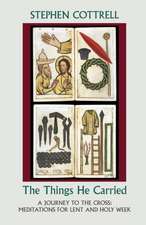Pray Like This: Understanding Prayer in the Bible
Autor Rodney A. Werlineen Limba Engleză Paperback – 20 iul 2007
Werline encourages us to look at prayer in the following way: to attempt to understand how prayers are tied to particular cultural and social settings. Prayers are part of and expressions of a collection of cultural ideas that have been arranged within a system that seems coherent and obvious to those writings the biblical texts. Prayers participate in and express a person's worldview. Werline shows the ways that--though many biblical prayers are familiar to us--biblical texts and contemporary readers come from different worlds.
The Hebrew Bible and the New Testament contain many prayers. Large volumes have been written on prayer within a single book, or within the writings of one author, like Paul, or an individual prayer, such as the Lord's Prayer. Werline does not examine every prayer in the Bible or even write exhaustively on a single prayer. He has highlighted a few significant features of each prayer, and some of the prayers vividly exhibit the influence of a particular society's vision. For example, he examines the prayers of 1 and 2 Kings and 1 and 2 Chronicles because of the ways they are tightly tied to the authors' views of history. The writers' interpretation of history profoundly influenced significant portions of the Bible as well as the literature of early Judaism.
The Hebrew Bible and the New Testament contain many prayers. Large volumes have been written on prayer within a single book, or within the writings of one author, like Paul, or an individual prayer, such as the Lord's Prayer. Werline does not examine every prayer in the Bible or even write exhaustively on a single prayer. He has highlighted a few significant features of each prayer, and some of the prayers vividly exhibit the influence of a particular society's vision. For example, he examines the prayers of 1 and 2 Kings and 1 and 2 Chronicles because of the ways they are tightly tied to the authors' views of history. The writers' interpretation of history profoundly influenced significant portions of the Bible as well as the literature of early Judaism.
Preț: 255.58 lei
Preț vechi: 294.80 lei
-13% Nou
Puncte Express: 383
Preț estimativ în valută:
48.91€ • 52.30$ • 40.78£
48.91€ • 52.30$ • 40.78£
Carte tipărită la comandă
Livrare economică 17 aprilie-01 mai
Preluare comenzi: 021 569.72.76
Specificații
ISBN-13: 9780567026330
ISBN-10: 0567026337
Pagini: 176
Dimensiuni: 161 x 228 x 13 mm
Greutate: 0.27 kg
Editura: Bloomsbury Publishing
Colecția T&T Clark
Locul publicării:New York, United States
ISBN-10: 0567026337
Pagini: 176
Dimensiuni: 161 x 228 x 13 mm
Greutate: 0.27 kg
Editura: Bloomsbury Publishing
Colecția T&T Clark
Locul publicării:New York, United States
Caracteristici
Provides an in-depth examination of biblical prayers and their settings, from the prayers of Abraham and Sarah to the prayers contained in Paul's letters.
Cuprins
Prayers from Different Worlds
Rodney A. Werline
Table of Contents
Introduction
Chapter One Prayer and the Family's Future: The Prayers of Abraham's Servant and Hannah
Chapter Two Prayer and History: 1 and 2 Kings and 1 and 2 Chronicles
Chapter Three Prayer and the Rejected Prophet: Jeremiah
Chapter Four Prayer and Wisdom: Daniel
Chapter Five Pray Like This: Matthew
Chapter Six Prayer and Demonic Powers: Mark
Chapter Seven Prayer and God's Continuing Work: Luke-Acts
Chapter Eight Prayer and Unity: John
Chapter Nine Prayer, Transformation, and Moral Advancement: Paul
Conclusion
Recenzii
'Books on prayer abound, and of books on prayers in the Bible there are many, but in this volume Rodney Werline challenges the way in which we have 'unconsciously' appropriated the language of biblical prayers without first considering their very particular cultural and social settings. After setting out the limits of his investigation and his definition of prayer, Werline explores a number of prayers from the Old and New Testaments. Werline's stated goal is not that we should return to 'biblical prayer, but rather that we may enter into conversation with the biblical prayers in order to notice both the discontinuities and continuities between them and our own prayers. This he does very successfully, deliberately using anecdotal stories to add depth and colour to the points he makes rather then lengthy theological treatises. Thankfully this style does not detract from a serious engagement with both Scripture and some key historical, anthropological and sociological questions. The result is an eminently readable book - capable of inspiring theological thinking in the average churchgoer, whilst challenging theological presuppositions in an ordinand or trainee minister.' - Sue Woan, Eastern Region Ministry Course, Norwich, UK, in the Expository Times.




